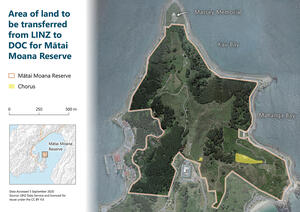
An aerial shot of Te Motu Kairangi (Miramar Peninsula) with Watts Peninsula in the foreground. Dave Greenberg/Shutterstock.com
Watts Peninsula is a culturally and historically significant area located near the entrance to Wellington Harbour. The land was occupied by Māori for pā, kāinga and mahinga kai, and throughout the past 160 years it has been used for coastal defence, farming and reformatory purposes.
Establishment of Mātai Moana reserve
A public reserve is in the final stages of being created with the transfer of 72 hectares of land on Watts Peninsula from LINZ to the Department of Conservation (DOC).
A charitable trust will manage the Mātai Moana reserve, with trustees appointed by Wellington City Council, Taranaki Whānui through the Port Nicholson Block Settlement Trust, and DOC.
The former Defence Force land is being transferred from LINZ to DOC under the Public Works Act and will then be formalised as a recreation reserve by DOC under the Reserves Act.
It’s expected the transfer will be complete by November 2025.
Because of hazards across the site, public access to the area is not authorised until the reserve is opened to the public by the Trust.
More information about the future of the reserve can be found on the Wellington City Council website

Disposal of remaining surplus Crown land
An area of Crown land (3.4ha) on the western boundary of the Mātai Moana reserve will remain under LINZ administration while possible disposal options are explored.
We continue to work through the disposal process for land at the former Wellington Prison at Mount Crawford.
This land was formerly managed by the Department of Corrections and is not part of the Mātai Moana reserve.
Read more about the Crown Property disposal process